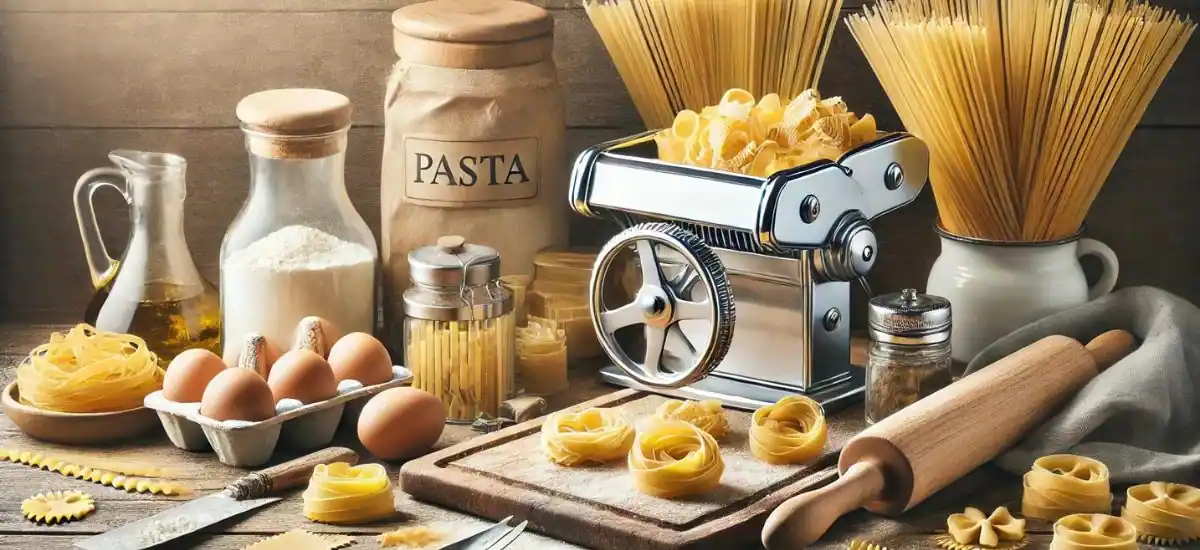Making homemade pasta transforms simple ingredients into a sublime culinary delight. Start by mixing flour, eggs, salt, and olive oil to create your dough. The key to perfect homemade pasta lies in the proper kneading and resting of the dough, which ensures a smooth and elastic texture. Roll the dough to your desired thickness, then cut into shapes like spaghetti or fettuccine. Fresh pasta cooks quickly in boiling salted water, offering a superior taste and texture compared to store-bought versions. Serve with your favorite sauce for a truly authentic Italian dining experience, celebrating the art of pasta making at home.
Ingredients Needed
Before you begin, let’s make sure you have everything you need:
- Flour: Type 00 is the gold standard for silky smooth pasta, but semolina works great for a firmer texture.
- Eggs: Fresh, large eggs will bind your flour into a rich, elastic dough.
- Salt: Just a pinch to enhance the flavors.
- Olive Oil: A splash for that tender touch in your dough.
- Optional: Feel free to jazz it up with some herbs or pureed spinach for a pop of color and flavor.
Tools and Equipment

Having the right tools can make your pasta-making process a breeze:
- Pasta Maker: Ideal for rolling and cutting, but a rolling pin and sharp knife can also get the job done.
- Mixing Bowls: Needed for mixing your dough to perfection.
- Cutting Board and Rolling Pin: Essential for shaping and cutting if you’re doing it by hand.
Preparing the Pasta Dough
Getting your dough right is the foundation of great pasta:
- Mixing: Start by sifting your flour into a mound on a clean surface. Make a well in the center and crack the eggs into it. Add your pinch of salt and olive oil.
- Combining: Using a fork, gently beat the eggs and begin to incorporate the flour from the sides of the well. Continue until the mixture is thick enough to work with your hands.
Kneading the Dough
Kneading is where the magic happens, turning simple ingredients into pasta dough:
- Technique: Once your dough starts to come together, knead it with the heels of your hands. Push it away from you, then fold it back over itself and repeat.
- Consistency: Knead for about 10 minutes or until the dough is smooth and elastic. It should spring back when poked.
Resting the Dough
Don’t skip the resting step—it’s key for a workable dough:
- Why Rest: Resting allows the gluten strands in the dough to relax, making it easier to roll out without tearing.
- How Long: Cover your dough with a clean dish towel and let it rest at room temperature for at least 30 minutes.
Rolling Out the Dough
Whether you’re using a machine or doing it by hand, rolling is crucial:
- Using a Pasta Machine: Divide your dough into smaller pieces. Flatten each piece slightly, then feed it through your pasta machine, starting with the widest setting and working your way to the desired thickness.
- By Hand: If you don’t have a machine, use a rolling pin to roll out your dough on a lightly floured surface. Aim for as thin as you can—translucent is ideal.
Cutting and Shaping Pasta
Now for the fun part—turning your sheets of dough into delicious pasta:
- Cutting: If you have a pasta machine, use the cutter attachment for shapes like spaghetti or fettuccine. For lasagna or ravioli, use a sharp knife or pizza cutter.
- Shaping by Hand: For shapes like farfalle or tagliatelle, you can cut with a knife and then shape with your hands.
Cooking the Pasta

Fresh pasta cooks much quicker than dried:
- Boiling: Bring a large pot of salted water to a boil. Add your pasta, stirring gently at first to prevent sticking.
- Timing: Fresh pasta usually cooks in 2-4 minutes. Taste a piece to ensure it’s al dente.
Serving Suggestions
Pair your freshly made pasta with the sauce of your choice:
- Classic Pairings: A simple tomato sauce or a light olive oil dressing lets the pasta shine.
- Rich Options: Creamy Alfredo or hearty Bolognese are great for a more decadent meal.
Storing Homemade Pasta
If you’ve made extra, here’s how to keep it:
- Drying: Lay pasta flat or hang it on a pasta drying rack until completely dry. Store in an airtight container.
- Freezing: For short-term storage, place fresh pasta in a single layer on a baking sheet to freeze, then transfer to a bag.
Frequently Asked Questions
Q1. Can I make pasta without eggs?
Ans: Yes, for a vegan option, you can use water and flour.
Q2. How long can homemade pasta be stored?
Ans: Dried pasta can last several months, while fresh pasta can be kept in the fridge for a couple of days or frozen for up to a month.
Conclusion
Homemade pasta is more than just a meal—it’s an experience. Each step, from kneading the dough to enjoying the finished dish, is a labor of love that pays off with every delicious bite.


